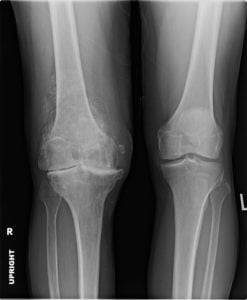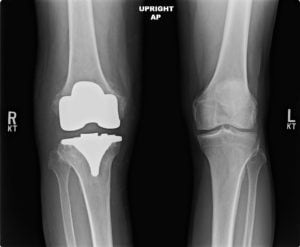What is Total Knee Replacement?
Knee arthroplasty, also known as knee replacement, is one of the most successful procedures in all of medicine. For patients with severe knee arthritis, this procedure can dramatically improve function and quality of life.
Total knee replacement involves “replacing,” or more specifically resurfacing, all three compartments of the knee. These compartments include the medial compartment (inside aspect), lateral compartment (outside aspect), and patellofemoral compartment (articulation between the kneecap and femur). The first and foremost purpose for total knee replacement is to relieve pain associated with arthritis and deformity of the knee.

Radiograph demonstrating severe right knee osteoarthritis in 61 yo construction worker. Note the deformity, loss of joint space, and osteophyte formation.
Why Does Arthritis Require Total Knee Replacement?
Arthritis of the knee can be due to many causes. Osteoarthritis is typical “wear and tear” arthritis that is closely associated with age. Rheumatoid arthritis is an autoimmune condition where the body actually attacks the joint and destroys the knee cartilage. Post-traumatic arthritis is degenerative change of a joint due to past trauma. All of these conditions lead to a final common pathway of loss of cartilage and pain. Patients have trouble with walking, pain at night, and decreased quality of life.
Conservative treatment options include joint injections, physical therapy, anti-inflammatory medications, and bracing. For significant arthritis that involves the entire knee joint, the only long-term solution is total knee replacement.
How Does Total Knee Replacement Treat Arthritis?
Total knee replacement involves removing the arthritic bone of the knee and resurfacing this area with highly polished metal (cobalt chromium usually) and a low-wear plastic insert (polyethylene). A midline longitudinal incision is used over the front of the knee to gain exposure for the surgery. The arthritic bone is removed through a series of small cuts while leaving the vast majority of the knee ligaments intact. The implants are either fixed to bone with bone cement or are attached via a press fit method where the bone will grow into the prosthesis.

Successful right total knee replacement in 61 yo male shown above. The alignment of the knee has been corrected and bony osteophytes have been removed. At 2 months postoperatively the patient had significantly improved range of motion and function. Most importantly the patient reported a dramatic decrease in knee pain.
The procedure is performed as an inpatient in a hospital setting. Typical hospital stay is two days but can vary based on a patient’s progress and needs. The two key variables that determine success in this procedure are the surgeon and the patient. The goal of the surgeon is to correctly implant the components while preserving ligamentous supports and muscular integrity.
Factors in a Successful Knee Replacement Surgery
There are several different ways to perform the procedure and most are shown to be equal in terms of patient outcomes. The key factors that have been shown to differentiate surgeons are subspecialty training in joint replacement and experience. Multiple studies have shown that surgeons with advanced training who routinely perform total knee replacement are able to obtain superior outcomes.

Example of a knee replacement prosthesis. Note the metallic femoral and tibial components separated by a polyethylene insert.
The other main variable in knee replacement is the patient. Patients who work hard postoperatively and dedicate themselves to physical therapy report substantially improved results compared to those who do not. As with any surgical procedure, there is the risk of complications with total knee replacement. The surgeons role is to educate the patient on the potential risks and to do everything possible to keep these risks to a minimum.
Dr. Wind’s Experience with Joint Replacement
Dr. Wind performs approximately 400 knee replacement procedures annually. This is more than any other surgeon in central Virginia. He also commonly evaluates patients who are considering joint replacement but wish to seek a second opinion. He also takes referrals from fellow surgeons on complex and challenging cases.
